Austria
Where the Danube River leaves the hills and turns south into the Great Hungarian Plain, north meets south and east meets west in Europe. As a result, Austrian's great role in history has been as a frontier post the protector and defender of Western civilization against the invanding tribes that time and again threatened to overrun the whole of Europe.
History of Austria: The journey into Austia's past begins in the early lron Age at Hall-statt in Upper Austria.Here careful excavation of ancient burial grounds has revealed the existence of a flourishing community that mined and traded salt.When the Cetls moved into Austria about the 3rd cenury B.C., they took over the thriving salt trade in such towns as Hallstatt and Salzburg and extended their kingdom of Noricum until it included most of Upper Austria,Salzburg, West Styria, and Carinthia.
There is evidence that the Romans had penetrated the region we call Austria by about 100 B.C by A.D. 10 they had established themselves as the sole rulers of the region they named Pannonia.The Romans were as interested in exploiting the trade of the area as they were in protecting their eastern frontier. The Danube River gave the Romans an east-west trade link.The most important north-south trade route was the so-called Amber Road, wich extended from Jutland in Denmark in the north carried whale tursks and amber (used for jewelry), which they traded for swords, pitchers,and, of course, salt.
For several hundred years the Romans were able to fight off the repeated attempts at invasions by barbarians from the north and east. During this period of relative peacefulness the Romans estblished the city of Vindobona (Vienna), and brought their language and later the Christian religion to the region.
But from about A.D. 400 onward, the weakened Roman Empire could no longer successfully defend Pannonia.By the end of the 5th century the country lay open to attack by wave after wave of barbarian invaders- Huns, Slavs , Avars, and Magyars from the east; Teutons from the north;and Bajuvars from the west. It was not until the time of Charlemagne in the 8th century that the region knew stable government again.
It lasted for only about a century.
In the year 976 Otto II, the Holy Roman Emperor, gave part of Austria to Leopold of Babenberg to rule as a duchy. The gift was perhaps a little less generous than it seems, for Otto II wanted to prtect his eastern frontier from further invasions, and it became the Babenberg's duty to keep the Magyars (Hungarians) at bay.
The Babenbergs set Austria on the road to steady growth in trade and prosperity. The eastern border of the duchy was never quiet, but it managed somehow to survive all attacks. After nearly 300 years of continuous rule, the last of the Babenbergs died in 1246 in a battle with the Magyars, their fiercest enemies. The Babenbergs had not only erected mighty fortresses to defend their duchy, but also built beautiful monastreries, such as the ones at Melk, Klosterneuburg, Heiligenkreuz , and Admont-splendid stone mementos of their deep religious faith. Christiantity had come to the land in the 4th century when Emperor Condtantine made it the state religion of Rome.Throughout the centuries that followed, the dukes, kings, and later the emperors of Austria took as their foremost duty the defence of Roman Catholicism against the heathens, the Muslims, and later the Protestant reformers.
http://www.youtube.com/watch?v=KyLSUZ1qlVM
Austrian language
German is Austria's official language and is spoken natively by 88.6% of the population—followed by Serbian/ Croatian/ Bosnian (4.2%), Turkish (2.3%), Hungarian (0.5%) and Polish(0.5%).
The official German used in education, publications, announcements and websites is Austrian German, which is mostly identical to the German used in Germany but with some vocabulary differences. Many local dialects are spoken in Austria, and though their base is Austrian German, their corresponding speakers meet certain degree of difficulty when trying to understand each other.
The Austrian federal states of Carinthia and Styria are home to a significant indigenous Slovene-speaking minority while in the easternmost state, Burgenland (formerly part of the Hungarian portion of Austria–Hungary), there are significant Hungarian- and Croatian-speaking minorities. Of the remaining number of Austria's people that are of non-Austrian descent, many come from surrounding countries, especially from the former East Bloc nations. So-called guest workers (Gastarbeiter) and their descendants, as well as refugees from the Yugoslav wars and other conflicts, also form an important minority group in Austria. Since 1994 the Roma–Sinti (gypsies) have been an officially recognised ethnic minority in Austria.
According to census information published by Statistik Austria for 2001 there were a total of 710,926 foreign nationals living in Austria. Of these, the largest by far are 283,334 foreign nationals from the former Yugoslavia (of whom 135,336 speak Serbian; 105,487 Croatian; 31,591 Bosnian – i.e. basically there are altogether 272,414 Austrian resident native speakers – plus 6,902 Slovenian and 4,018 Macedonian speakers).
The second largest population of linguistic and ethnic groups are the Turks (including minority of Kurds) with a number of 200,000 to 300,000 who currently live in Austria. The Turks and The Kurds are the largest single immigrant group in Austria, closely followed by the Serbs.
As of 2006, some of the Austrian states introduced standardised tests for new citizens, to assure their language ability, cultural knowledge and accordingly their ability to integrate into the Austrian society.For the national rules, see Austrian nationality law – Naturalisation.



Комментарии
Отправить комментарий